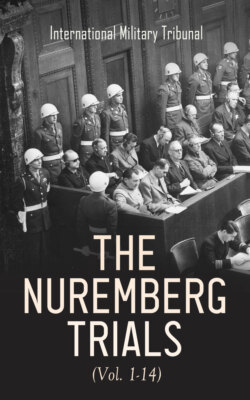Читать книгу The Nuremberg Trials (Vol. 1-14) - International Military Tribunal - Страница 34
(C) MURDER AND ILL-TREATMENT OF PRISONERS OF WAR,
AND OF OTHER MEMBERS OF THE ARMED FORCES OF THE
COUNTRIES WITH WHOM GERMANY WAS AT WAR, AND OF
PERSONS ON THE HIGH SEAS
ОглавлениеThe defendants murdered and ill-treated prisoners of war by denying them adequate food, shelter, clothing and medical care and attention; by forcing them to labor in inhumane conditions; by torturing them and subjecting them to inhuman indignities and by killing them. The German Government and the German High Command imprisoned prisoners of war in various concentration camps, where they were killed and subjected to inhuman treatment by the various methods set forth in paragraph VIII (A). Members of the armed forces of the countries with whom Germany was at war were frequently murdered while in the act of surrendering. These murders and ill-treatment were contrary to International Conventions, particularly Articles 4, 5, 6, and 7 of the Hague Regulations, 1907, and to Articles 2, 3, 4, and 6 of the Prisoners of War Convention (Geneva 1929), the laws and customs of war, the general principles of criminal law as derived from the criminal laws of all civilized nations, the internal penal laws of the countries in which such crimes were committed, and to Article 6 (b) of the Charter.
Particulars by way of example and without prejudice to the production of evidence of other cases, are as follows:
1. In the Western Countries:
French officers who escaped from Oflag X C were handed over to the Gestapo and disappeared; others were murdered by their guards; others sent to concentration camps and exterminated. Among others, the men of Stalag VI C were sent to Buchenwald.
Frequently prisoners captured on the Western Front were obliged to march to the camps until they completely collapsed. Some of them walked more than 600 kilometers with hardly any food; they marched on for 48 hours running, without being fed; among them a certain number died of exhaustion or of hunger; stragglers were systematically murdered.
The same crimes have been committed in 1943, 1944, and 1945 when the occupants of the camps were withdrawn before the Allied advance; particularly during the withdrawal of the prisoners of Sagan on 8 February 1945.
Bodily punishments were inflicted upon non-commissioned officers and cadets who refused to work. On 24 December 1943, three French non-commissioned officers were murdered for that motive in Stalag IV A. Many ill-treatments were inflicted without motive on other ranks: stabbing with bayonets, striking with riflebutts, and whipping; in Stalag XX B the sick themselves were beaten many times by sentries; in Stalag III B and Stalag III C, worn-out prisoners were murdered or grievously wounded. In military jails in Graudenz for instance, in reprisal camps as in Rava-Ruska, the food was so insufficient that the men lost more than 15 kilograms in a few weeks. In May 1942, one loaf of bread only was distributed in Rava-Ruska to each group of 35 men.
Orders were given to transfer French officers in chains to the camp of Mauthausen after they had tried to escape. At their arrival in camp they were murdered, either by shooting or by gas, and their bodies destroyed in the crematorium.
American prisoners, officers and men, were murdered in Normandy during the summer of 1944 and in the Ardennes in December 1944. American prisoners were starved, beaten, and otherwise mistreated in numerous Stalags in Germany and in the occupied countries, particularly in 1943, 1944, and 1945.
2. In the Eastern Countries:
At Orel prisoners of war were exterminated by starvation, shooting, exposure, and poisoning.
Soviet prisoners of war were murdered en masse on orders from the High Command and the Headquarters of the SIPO and SD. Tens of thousands of Soviet prisoners of war were tortured and murdered at the “Gross Lazaret” at Slavuta.
In addition, many thousands of the persons referred to in paragraph VIII (A) 2, above, were Soviet prisoners of war.
Prisoners of war who escaped and were recaptured were handed over to SIPO and SD for shooting.
Frenchmen fighting with the Soviet Army who were captured were handed over to the Vichy Government for “proceedings”.
In March 1944, 50 R.A.F. officers who escaped from Stalag Luft III at Sagan, when recaptured, were murdered.
In September 1941, 11,000 Polish officers who were prisoners of war were killed in the Katyn Forest near Smolensk.
In Yugoslavia the German Command and the occupying authorities in the person of the chief officials of the Police, the SS troops (Police Lieutenant General Rosener) and the Divisional Group Command (General Kübler and others) in the period 1941-43 ordered the shooting of prisoners of war.
